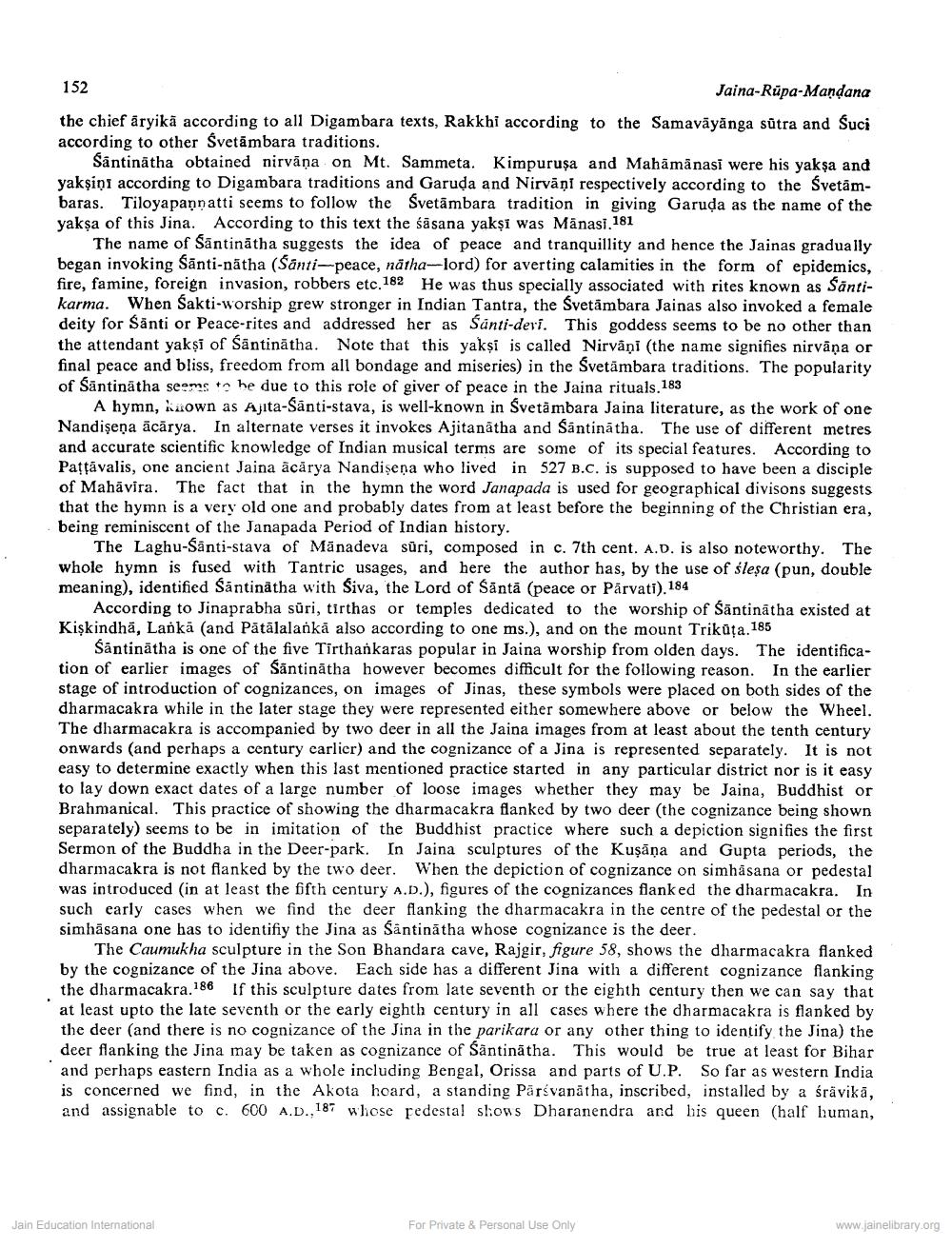________________
152
Jaina-Rupa-Mandana the chief äryikā according to all Digambara texts, Rakkhi according to the Samavāyānga sūtra and Suci according to other Svetāmbara traditions.
Santinātha obtained nirvāṇa on Mt. Sammeta. Kimpurușa and Mahämänasi were his yaksa and yakşiņi according to Digambara traditions and Garuda and Nirvāņi respectively according to the Svetāmbaras. Tiloyapannatti seems to follow the Svetāmbara tradition in giving Garuda as the name of the yakşa of this Jina. According to this text the śāsana yakṣi was Mānasi.181
The name of Sāntinātha suggests the idea of peace and tranquillity and hence the Jainas gradually began invoking Sānti-nätha (Santi-peace, nätha-lord) for averting calamities in the form of epidemics, fire, famine, foreign invasion, robbers etc. 182 He was thus specially associated with rites known as Santikarma. When Sakti-worship grew stronger in Indian Tantra, the Svetämbara Jainas also invoked a female deity for Sänti or Peace-rites and addressed her as Santi-deri. This goddess seems to be no other than the attendant yakşi of Santinātha. Note that this yaksi is called Nirvani (the name signifies nirvāņa or final peace and bliss, freedom from all bondage and miseries) in the Svetāmbara traditions. The popularity of Säntinātha seems to he due to this role of giver of peace in the Jaina rituals. 183
A hymn, luown as Ajita-Santi-stava, is well-known in Svetambara Jaina literature, as the work of one Nandişena ācārya. In alternate verses it invokes Ajitanātha and Santinātha. The use of different metres and accurate scientific knowledge of Indian musical terms are some of its special features. According to Pastāvalis, one ancient Jaina ācārya Nandişeņa who lived in 527 B.C. is supposed to have been a disciple of Mahavira. The fact that in the hymn the word Janapada is used for geographical divisons suggests that the hymn is a very old one and probably dates from at least before the beginning of the Christian era, being reminiscent of the Janapada Period of Indian history.
The Laghu-Santi-stava of Mänadeva sūri, composed in c. 7th cent. A.D. is also noteworthy. The whole hymn is fused with Tantric usages, and here the author has, by the use of slesa (pun, double meaning), identified Santinátha with Siva, the Lord of Santā (peace or Pärvati). 184
According to Jinaprabha sūri, tirthas or temples dedicated to the worship of Santinātha existed at Kiskindha, Lanka (and Pātālalankä also according to one ms.), and on the mount Trikāta. 185
Santinātha is one of the five Tirthankaras popular in Jaina worship from olden days. The identification of earlier images of Säntinātha however becomes difficult for the following reason. In the earlier stage of introduction of cognizances, on images of Jinas, these symbols were placed on both sides of the dharmacakra while in the later stage they were represented either somewhere above or below the Wheel. The dharmacakra is accompanied by two deer in all the Jaina images from at least about the tenth century onwards (and perhaps a century carlier) and the cognizance of a Jina is represented separately. It is not easy to determine exactly when this last mentioned practice started in any particular district nor is it easy to lay down exact dates of a large number of loose images whether they may be Jaina, Buddhist or Brahmanical. This practice of showing the dharmacakra flanked by two deer (the cognizance being shown separately) seems to be in imitation of the Buddhist practice where such a depiction signifies the first Sermon of the Buddha in the Deer-park. In Jaina sculptures of the Kuşāna and Gupta periods, the dharmacakra is not flanked by the two deer. When the depiction of cognizance on simhasana or pedestal was introduced (in at least the fifth century A.D.), figures of the cognizances flanked the dharmacakra. In such early cases when we find the deer flanking the dharmacakra in the centre of the pedestal or the simhāsana one has to identifiy the Jina as Såntinātha whose cognizance is the deer.
The Caumukha sculpture in the Son Bhandara cave, Rajgir, figure 58, shows the dharmacakra flanked by the cognizance of the Jina above. Each side has a different Jina with a different cognizance flanking the dharmacakra.186 If this sculpture dates from late seventh or the eighth century then we can say that at least upto the late seventh or the early eighth century in all cases where the dharmacakra is flanked by the deer (and there is no cognizance of the Jina in the parikara or any other thing to identify the Jina) the deer flanking the Jina may be taken as cognizance of Santinātha. This would be true at least for Bihar and perhaps eastern India as a whole including Bengal, Orissa and parts of U.P. So far as western India is concerned we find, in the Akota hoard, a standing Pārsvanatha, inscribed, installed by a śrävikā, and assignable to c. 600 A.D.,187 whose pedestal shows Dharanendra and his queen (half human,
Jain Education International
For Private & Personal Use Only
www.jainelibrary.org




